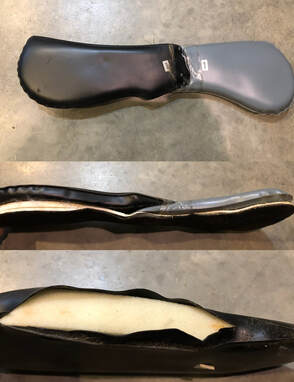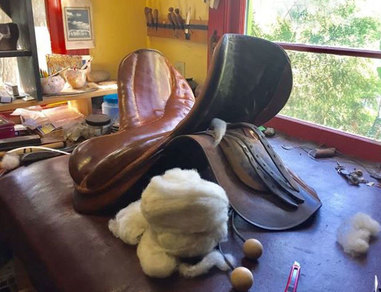Wool, Foam or Air
A master saddler weighs in on which material works best in saddle panels.
by David Young, British Master Saddler
Depending on which manufacturer you talk to and what they use in their saddles, you will get very different opinions as to which material is best. But how much is marketing and how much is fact? Having worked with all three materials, I must admit to a bias for wool, which I find significantly superior for the reasons stated here.
by David Young, British Master Saddler
Depending on which manufacturer you talk to and what they use in their saddles, you will get very different opinions as to which material is best. But how much is marketing and how much is fact? Having worked with all three materials, I must admit to a bias for wool, which I find significantly superior for the reasons stated here.
Foam
A well-fitted foam saddle with quality foam material can be a good fit for your horse.
The issue that I am seeing is when customers have bought a foam saddle second hand, online or off the shelf with panels that did not match their horses confirmation and I am not able to assist in many cases.
A foam panel that has, for example, a modified trapezius panel that was perhaps made for horse with more of a with pocket should not be used on a horse that has a rounder shape. The pressure of the panels could cause some serious pressure points. As with everything - it comes to proper fit and management. If a qualified and educated rep of the company comes and checks, and if needed, modifies the foam panels on a regular basis then they may be just fine.
If however the uneducated rider buys a saddle just because of the brand and pays little attention to the fit of the panel, you may experience trouble. Foam saddle modification will be harder and more expensive to do since it can't be done on site like flocking adjustments. Foam may also create more heat and, depending on the quality of the foam used, may be very hard or soft and may disintegrate over time, which will require a complete new panel, rather than just a flocking adjustment.
A well-fitted foam saddle with quality foam material can be a good fit for your horse.
The issue that I am seeing is when customers have bought a foam saddle second hand, online or off the shelf with panels that did not match their horses confirmation and I am not able to assist in many cases.
A foam panel that has, for example, a modified trapezius panel that was perhaps made for horse with more of a with pocket should not be used on a horse that has a rounder shape. The pressure of the panels could cause some serious pressure points. As with everything - it comes to proper fit and management. If a qualified and educated rep of the company comes and checks, and if needed, modifies the foam panels on a regular basis then they may be just fine.
If however the uneducated rider buys a saddle just because of the brand and pays little attention to the fit of the panel, you may experience trouble. Foam saddle modification will be harder and more expensive to do since it can't be done on site like flocking adjustments. Foam may also create more heat and, depending on the quality of the foam used, may be very hard or soft and may disintegrate over time, which will require a complete new panel, rather than just a flocking adjustment.

Air Panels
When air panels first came out there was a lot of buzz and enthusiasm that lasted for a couple of years of trial. Many saddles were converted to foam at a dear price and later reconverted back to wool. Although a clever and interesting alternative, they have failed to replace wool as the premium material for a variety of reasons. Air is unstable and tends to expand and contract as temperatures change. There have been many problems with leaking valves leaving the rider with a “flat” before a big competition. Unlike wool, you can’t just compensate with a little more padding to get you through.
As the rider’s weight goes forward the air tends to be forced in the opposite direction leaving the back unprotected.
If there is too little air pressure, the horse’s back may be exposed to the tree.
If there is too much, the saddle often rocks on the horse’s back.
A Swiss study indicated that some riders reported a lack of communication and effectiveness via their riding aids when riding on air panels.
As for CAIR panels: I found only pieces of cheap vinyl,filled with a cheap looking foam. I've felt either overlapping of these pieces or bridging. I recommend converting these to wool.
When air panels first came out there was a lot of buzz and enthusiasm that lasted for a couple of years of trial. Many saddles were converted to foam at a dear price and later reconverted back to wool. Although a clever and interesting alternative, they have failed to replace wool as the premium material for a variety of reasons. Air is unstable and tends to expand and contract as temperatures change. There have been many problems with leaking valves leaving the rider with a “flat” before a big competition. Unlike wool, you can’t just compensate with a little more padding to get you through.
As the rider’s weight goes forward the air tends to be forced in the opposite direction leaving the back unprotected.
If there is too little air pressure, the horse’s back may be exposed to the tree.
If there is too much, the saddle often rocks on the horse’s back.
A Swiss study indicated that some riders reported a lack of communication and effectiveness via their riding aids when riding on air panels.
As for CAIR panels: I found only pieces of cheap vinyl,filled with a cheap looking foam. I've felt either overlapping of these pieces or bridging. I recommend converting these to wool.

Wool Flocked Panels
Wool has always been the saddler’s choice for flocking panels.
Wool flocked panels are not assembly line made with the one size fits all attempt in mind. Wool is extremely comfortable on the horse’s back and disperses the rider’s weight over a broader surface area, assuming the correct design and fit of the saddle. Because wool flock consists of “long individual strands” it can easily conform to the polymorphous shapes of the horses’ backs. Foam, regardless of how soft it may feel, does not compare to wool’s ability to conform. It can be easily adjusted to compensate for asymmetry in the horse’s conformation. It can be completely replaced in older saddles for relatively little cost. Wool provides stable support for the rider’s weight and it has no sharp edges. An often-heard criticism of wool from manufacturers who use foam panels is that wool knots up. I rarely find knots in wool panels unless it was improperly flocked by a novice. If there are knots, they can easily be removed and replaced with fresh wool. Typically wool only knots when it is being removed from the panels.
(Note: Wool panels alone do not guarantee comfort for the horse and cannot compensate for a poorly designed or fitted saddle.)
The bad news is that wool panels need to be topped off or adjusted regularly to compensate for compression or changes in the horse’s back due to a variety of reasons including diet, training, age and season, etc. And I recommend a strip flock after a few years since wool is a natural material that will absorb sweat and moisture and will loose its natural spring.
The good news is that they easily can be!
Wool has always been the saddler’s choice for flocking panels.
Wool flocked panels are not assembly line made with the one size fits all attempt in mind. Wool is extremely comfortable on the horse’s back and disperses the rider’s weight over a broader surface area, assuming the correct design and fit of the saddle. Because wool flock consists of “long individual strands” it can easily conform to the polymorphous shapes of the horses’ backs. Foam, regardless of how soft it may feel, does not compare to wool’s ability to conform. It can be easily adjusted to compensate for asymmetry in the horse’s conformation. It can be completely replaced in older saddles for relatively little cost. Wool provides stable support for the rider’s weight and it has no sharp edges. An often-heard criticism of wool from manufacturers who use foam panels is that wool knots up. I rarely find knots in wool panels unless it was improperly flocked by a novice. If there are knots, they can easily be removed and replaced with fresh wool. Typically wool only knots when it is being removed from the panels.
(Note: Wool panels alone do not guarantee comfort for the horse and cannot compensate for a poorly designed or fitted saddle.)
The bad news is that wool panels need to be topped off or adjusted regularly to compensate for compression or changes in the horse’s back due to a variety of reasons including diet, training, age and season, etc. And I recommend a strip flock after a few years since wool is a natural material that will absorb sweat and moisture and will loose its natural spring.
The good news is that they easily can be!
